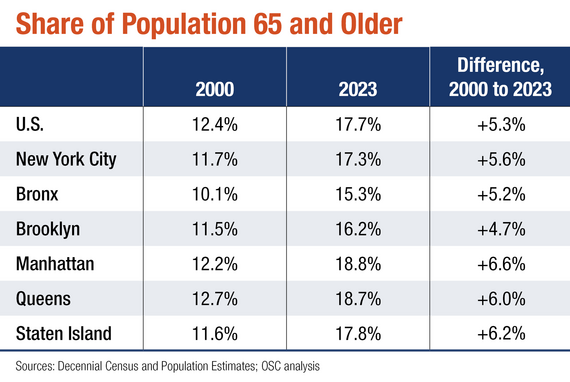As the population of older New Yorkers jumps higher, the city's Department for the Aging will require additional funding to support its senior population, according to a new report by New York State Comptroller Thomas P. DiNapoli.
New York City’s 65 and older population grew by nearly half a million seniors in the last two decades, an increase of 53%, the report found. Much of the growth was led by Asian, Hispanic and Black seniors, along with more seniors born outside the U.S., according to a press release.
Although the COVID-19 pandemic caused a decline in the city’s total population, the number of adults 65 and older increased by 6.4% from 2020 to 2023, led by recent growth in Queens.

DiNapoli said this growth in senior population calls for a higher budget for the DFTA to ensure a sufficient allocation of essential resources to its beneficiaries.
“Many older adults are living on fixed incomes and no one wants to see them priced out of their homes because of a lack of supportive services,” DiNapoli said. “It’s imperative that the city’s Department for the Aging has the funding necessary to provide critical programs and services that improve affordability, safety and access to care. Many may not realize the senior population has grown substantially, and is far more diverse now, which means a special focus on reaching seniors in multiple communities and languages is needed," he said.
Without sufficient funding, services including older adult centers, naturally occurring retirement communities and home-delivered meals could face severe cuts.
The report reveals that from FY 2020 to FY 2024, federal pandemic aid provided $210 million to bolster these services. Although the city extended funding into FY 2025, this support is set to lapse in FY 2026. DiNapoli also noted that DFTA’s spending has outpaced the city’s overall budget growth since 2010, underscoring the increased demand for senior services.
The report paints a stark picture of the financial struggles faced by older adults in New York City:
- Employment Needs: The number of older adults seeking employment grew from 200,000 to 286,000 over the past decade. In 2023, the median household income for seniors was $46,359, significantly lower than the citywide median of $76,577.
- Health Care Disparities: Among older adults in poverty, only 31% reported being in good or better health in 2019. Additionally, over 600,000 seniors were enrolled in Medicaid in 2023, accounting for 14% of city enrollees. More than one-third of seniors reported living with a disability, a rate higher than the national average.
- Housing Costs: In 2023, 61% of older tenants were rent burdened, with Staten Island experiencing the highest rate (70%), followed by Queens (66%), Brooklyn (62%), the Bronx (60%) and Manhattan (58%). For homeowners, 39.5% of senior households spent at least 30% of their income on housing expenses.
- Poverty Rates: Approximately 21.5% of the city’s senior population lived in poverty in 2023, compared to the citywide poverty rate of 18.2%. The proportion of older adults receiving cash assistance has also rose from 10% to 15% over the past decade.




